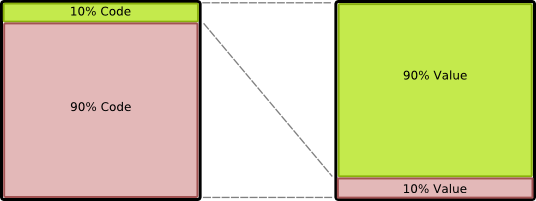
| Previous | Next | Printer friendly |
Business value and maintenance
Although much of the code in a typical IT system adds little business value, there is a huge value in keeping it well maintained.
I don't know exactly how you could measure it, but I reckon that if you examined a typical IT system you would find that more than 90% of the value comes from less than 10% of the code.

The 10% is the code that directly stores, transforms or communicates valuable business information. The 10% is the reason you run the system. Everything that is unique about your business or your product is in the 10%.
The 90% is the code that supports the 10%. It is all the admin and infrastructural stuff, like user management, security, screen handling, housekeeping and interfaces. The 90% is the same in every other system, and adds no particular value to your business or your product. You would not bother with the 90%, other than that it supports the 10%.
This split explains why application frameworks are valuable. They provide the 90% out of the box, leaving you to focus your energies on the 10%.
The split shows you where you should focus when you are defining, piloting or demonstrating software. A colleague or customer is not going to be impressed with your slick user password change screen; they want to see what it valuable and unique about the solution.
The split also helps understand long-term management priorities.
You might think that because the 90% is of little value, you can get away with quick and dirty solutions, leaving your best work for the 10%.
However, you could argue the opposite. The 90% is relatively stable. Although it adds little value when it works right, it undermines all the value when it does not work. You want it to "just work" to support the rest. It needs good documentation, good test packs, and good disciplines, but it is relatively easy to achieve this because the code is stable.
The 10% is likely to be changed and modified more, as you explore more valuable and unique ways to support your business or your customers. It is less stable, and a constant focus of work. You do need good documentation, testing and disciplines, but you also need to explore new functionality, try new things, and maybe take some risks.
The 90% has a huge impact on the return on investment for the system. If you keep the 90% in good order, then you can redevelop the 10% without having to rewrite the whole thing. However, if the 90% is badly maintained, it will not let you make major modifications to the 10%. If the 90% is very bad, it may even force a complete rewrite, even if the 10% of valuable code does not need it. Your supporting code should aid the longevity of the valuable code, not undermine it.
For all these reasons, do not ignore the supporting code in your IT systems. It needs to be managed well so that it does not get in the way, leaving you to devote your energies to the more valuable and dynamic code that adds unique value to your business.
Next: Vote Minimal, again!Subscription
Latest newsletter:
Magical metadata
We use the term "metadata-driven" to describe IT solutions in which functionality is defined in data. Taking this to the extreme can provide unparalleled levels of speed, simplicity and versatility.
Read full newsletter
System governance
System governance helps you implement high-quality systems, manage existing systems proactively, and improve failing systems.
Copyright © 2005-2015 Minimal IT Ltd. All rights reserved.
Minimal IT: research, training, consultancy and software to reduce IT costs.
